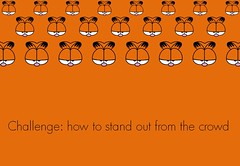Monday, August 31, 2009
Slides that Stick

Jan Schultink over at Slides that Stick just shared several of his designs on Flickr. They are great fodder for ideas. Check them out here.
Friday, August 28, 2009
Thursday, August 27, 2009
Toward a Theology of PowerPoint #4
 John starts his first letter like this:
John starts his first letter like this:1That which was from the beginning, which we have heard, which we have seen with our eyes, which we have looked at and our hands have touched—this we proclaim concerning the Word of life. 2The life appeared; we have seen it and testify to it, and we proclaim to you the eternal life, which was with the Father and has appeared to us. 3We proclaim to you what we have seen and heard, so that you also may have fellowship with us. And our fellowship is with the Father and with his Son, Jesus Christ. (1 John 1:1-3)
Wednesday, August 26, 2009
The Surround Sound Effect
 "The Surround Sound Effect" is the name that I have given to technology that can interfere with its purpose.
"The Surround Sound Effect" is the name that I have given to technology that can interfere with its purpose.I learned about this when I was pining away for surround sound of my very own. I listened to a bunch of systems and talked to a lot of my friends and researched all over the internet. Some people recommended the highest quality tuner and speakers with lots of number and letters all proclaiming the awesomeness of the system. Other people recommended the home theater in a box (HTB) set-up so that it would be easy to put together and enjoy.
What I discovered is that the truth was somewhere in the middle. I needed a system that was good enough that I wouldn't notice the poor quality (most HTB's don't fit the bill here), but I also needed a system that wasn't so good that I got distracted by trying to eek out the highest quality sound (i.e. constantly having to fiddle with settings when changing media inputs).
The principle is this: technology is supposed to fade into the background to allow us to experience the media. If your TV is too good or too bad that it's getting in the way, then it's not doing its job. If your PowerPoint presentation, projector, screen, etc. is distracting from the sermon, then it has failed at its job.
I really love technology (always and forever), but we need to remember that the purpose of technology is to allow the media to come through better, not to show off how cool the technology is.
Tuesday, August 25, 2009
PowerPoint tips and tricks #3
 My friend Mick pointed me to an online presentation creator called Prezi that does some really cool zooming and turning effects to give motion and drama to a presentation.
My friend Mick pointed me to an online presentation creator called Prezi that does some really cool zooming and turning effects to give motion and drama to a presentation.Monday, August 24, 2009
Resources that go unnoticed
 Of the most important resources for putting together a great presentation, I think the most neglected is pen-and-paper.
Of the most important resources for putting together a great presentation, I think the most neglected is pen-and-paper.Friday, August 21, 2009
Q&A Friday
 Today it's time for some healthy discussion. What questions do you have about PowerPoint, video, MediaShout, EasyWorship, podcasting, or anything else?
Today it's time for some healthy discussion. What questions do you have about PowerPoint, video, MediaShout, EasyWorship, podcasting, or anything else?Thursday, August 20, 2009
Toward a Theology of PowerPoint #3
 570 years ago Johannes Gutenberg changed the world. With the release of his closely guarded secret, movable type printing came to Europe for the first time. Since then every aspect of our communication has changed.
570 years ago Johannes Gutenberg changed the world. With the release of his closely guarded secret, movable type printing came to Europe for the first time. Since then every aspect of our communication has changed.Wednesday, August 19, 2009
Graphic Design for Dummies

PowerPoint, by its very existence, causes a problem: just because you can do something doesn't mean you should do something.
Ten years ago, you had a wide range of excuses for being a lousy visuals person. Starting with no talent, leading to no skill and going from there.
But now, in a world where it is expected that professionals will be able to make beautiful powerpoint slides, handsome business cards, clever bio photos and a decent website, it's as important as driving. And easier to learn and do, and requiring less talent.
No, you and I will never be gifted designers or breakthrough designers. But there's really no reason not to be really good.
Tuesday, August 18, 2009
To visualize or not to visualize
He juxtaposes the neurological research of David Phillips with the homiletic prowess of John Piper (Piper video below).
Phillips says:
What I discovered was when the brain receives sensory inputs, it transforms them into images. In other words, the brain learns, adapts, and is literally re-wired through images . . . We need to communicate in images. Whether it is video clips, or images in our sermon or verbal images, if we want to communicate for behavioral change, we need to communicate in images.
Piper on the other hand says:
I think the use of video and drama largely is a token of unbelief in the power of preaching. And I think that, to the degree that pastors begin to supplement their preaching with this entertaining spice to help people stay with them and be moved and get helped, it's going to backfire.... It's going to communicate that preaching is weak, preaching doesn't save, preaching doesn't hold, but entertainment does.
So . . . what do you think? Who do you think is right?
The Conference Table Effect
 The Conference Table Effect is a term I use to describe what happens when an idea is discussed too long by the same people with no outside input or critique.
The Conference Table Effect is a term I use to describe what happens when an idea is discussed too long by the same people with no outside input or critique.For example, RadioShack is in the process of rebranding themselves as The Shack, giving up on almost 90 years of work under their old name. Saying that customers are already dropping the "Radio" when referring to the company, they decided to embrace it.
I'm sorry, but that's dumb. RadioShack is an historical icon in the electronics industry and they succumbed to the Conference Table Effect. They discussed the idea around a conference table and a bad idea eventually started to seem good.
This is similar to when you were a kid and would say the same word over and over until it sounded weird. Repetition distorts our perception of things. Sometimes we just need a fresh perspective.
When creating a PowerPoint, it is possible to get so into the details of what you're doing that you lose perspective of the whole. Get some external critique. Take some time away from the project. Start slow. Don't be another victim of the Conference Table Effect
Monday, August 17, 2009
Love and Respect
Book Review: Envisioning the Word
 The book Envisioning the Word: The Use of Visual Images in Preaching has been on my to-read pile for a long time now. Since I'm finally done with the M.Div I get to read what I want to read and not what I'm told to read.
The book Envisioning the Word: The Use of Visual Images in Preaching has been on my to-read pile for a long time now. Since I'm finally done with the M.Div I get to read what I want to read and not what I'm told to read.Friday, August 14, 2009
The church you know
Thursday, August 13, 2009
Is Predictive Texting Making Kids Dumber?
 Ok, first of all, I just have to say that I love the visual that went along with this article - I had to bring it over to share.
Ok, first of all, I just have to say that I love the visual that went along with this article - I had to bring it over to share.The linked article above looks at a correlative study in which the use of predictive text messaging is linked to a high rate of speed in completing tests and a high rate of errors on the same tests in a group of Australian students.
The researchers determined that the subjects who used their phones more frequently, especially for predictive texting (the services that automatically complete words), finished tests sooner than other subjects, but with more incorrect answers. Researcher and epidemiology professor Michael Abramson told ABC Science that predictive texting is "training kids to be fast but inaccurate." He went on to explain, "If you're used to... entering a couple of letters and getting the word you want, you expect [the world] to be like that."So, what does this have to do with PowerPoint in preaching? Well, I have heard similar claims about the projection of Scripture, that it makes people too stupid to use their bibles. Or that when we project images of our examples that it prevents people from using their own imaginations (therefore making them dumber).
Really!?
These are some odd connections to draw. What is even worse is the illogical assumption that there is a causative effect in these situations. What we are seeing is a correlation between data. I do think that we need to be careful and thoughtful in the ways we use technology - we are affected by the things we do and the ways in which we do them. But technology is not the cause in most of these cases. Technology is amoral not immoral. If you have a problem, look to the person using the technology.
Toward a Theology of PowerPoint #2
 "I have become all things to all men so that by all possible means I might save some." 1 Cor. 9:22
"I have become all things to all men so that by all possible means I might save some." 1 Cor. 9:22Wednesday, August 12, 2009
Brain Rule #4: We don't pay attention to boring stuff
 Our brains are designed to pay attention to the important things and to ignore the boring things, says John Medina's Brain Rules.
Our brains are designed to pay attention to the important things and to ignore the boring things, says John Medina's Brain Rules.The 10-minute attention spanAfter an amount of time disappointing to teachers and PowerPoint presenters everywhere, audience attention drops precipitously.You must do something emotionally relevant at each 10-minute mark to regain attention.
Tuesday, August 11, 2009
PowerPoint tips and tricks #2
 Video Clips in PowerPoint:
Video Clips in PowerPoint:Monday, August 10, 2009
Live as Light
PowerPoint is Evil
 Edward Tufte wrote an article for Wired a while back (here) in which he talks about how awful PowerPoint can be.
Edward Tufte wrote an article for Wired a while back (here) in which he talks about how awful PowerPoint can be.Imagine a widely used and expensive prescription drug that promised to make us beautiful but didn't. Instead the drug had frequent, serious side effects: It induced stupidity, turned everyone into bores, wasted time, and degraded the quality and credibility of communication. These side effects would rightly lead to a worldwide product recall.
Edward R. Tufte is professor emeritus of political science, computer science and statistics, and graphic design at Yale. His new monograph, The Cognitive Style of PowerPoint, is available from Graphics Press (www.edwardtufte.com).
Friday, August 07, 2009
Cacophoty

I have been doing some research on the use of PowerPoint (specifically in sermons since that's my field). Ok, more to the point - I have seen some pretty bad PowerPoint presentations and been prompted to not be "that guy." So I think I've come up with a new word (or neologism for all you nerds out there).
My new word is: cacophoty n. (ka-KA-foe-tee)An image, moving or still, that is jarring and discordant; visual dissonance. As in: That PowerPoint slide was filled with clip art and bright, conflicting colors - it is a cacophoty.
So it's pretty much a rip off of the pre-existing word: cacophony. I applied my stupendous Greek skills and broke down the work into it's parts: caca (evil, bad) and phony (sound, voice). Then I just replaced 'phony' with 'photy' (light). I know, I know, you are amazed at the breadth and depth of my linguistic knowledge.
So go and use this new word - spread it around the globe. I don't really care if I get credit for it, I just think it would be cool to be watching the news in a couple years and hear them use my word.
Oh, and don't have cacophotous PowerPoints they make me want to scoop out my eyeballs with a soupspoon.
Thursday, August 06, 2009
Edit your Images Online

Lifehacker recently covered several online image editing tools (including Photoshop). The really cool thing about doing things online is that you don't have to buy really expensive software and keep it up to date (for example I can no longer use my copy of Photoshop Elements because of my new Windows Vista laptop). They have several listed in the post, but Aviary Phoenix came out on top.
Wednesday, August 05, 2009
Enlarge Images without Making them Blocky
So if you just can't find a version of the picture large enough to project without it looking all grainy and distorted, perhaps this can help.
Below I show what a couple minutes of dinking around can accomplish. It's not perfect, but it sure looks a lot better.


Finding Photos

The good folks over at Lifehacker detail some neat changes in the searching options at Flickr.
When you search for photos by keyword on Flickr, you get a grid of thumbnails, each of which pops up full-sized versions in-page. (No more having to click to a new page to see what the image looks like close up and other stats.) You can set how big the thumbnails should be, and also sort results by Flickr's magical (and very useful) "Interestingness" rank.
To find Creative Commons-licensed photos only you still have to click on the "Advanced Search" link; but you can bypass that step with a little URL hacking. Append
&l=ccto your search keyword shortcut to limit Flickr results to re-publishable images. Firefox keyword bookmark users: the full Flickr CC image search bookmark URL should behttp://www.flickr.com/search/?q=%s&l=cc. (Use&l=commderivfor images licensed for commercial use and derivative works.)
Slide Share
Below you can find one of my sermons on Romans 8.
Tuesday, August 04, 2009
11 ways to use images poorly in slides
As digital cameras have become ubiquitous, and cheap (or free) photo websites plentiful, more people than ever are using images in presentations. Images are not appropriate for every kind of talk, but even when images are appropriate (such as keynote/ballroom style presentations), people are still making the same common mistakes. So here are some things to keep in mind if you use images in your next talk
1. Image is too small
4. Image is of poor quality
6. Image is stretched horizontally and distorted
9. Clip art is chosen (see above)
10. Image is lame and and has nothing to do with content
Monday, August 03, 2009
Until Christ is Formed in You
I'm proud of the way that I used images to communicate the example of being formed. Note: the images of the painting, and baby faded smoothly without individual clicks in between.
I like the non-verbal way of showing Christ coming into focus toward the end of the show.
I used way too many words in this show. I'm ashamed of all the bullet points and text up on the screen. I've grown a lot since then (as you'll see in other presentations I post).
Please critique this for me.





